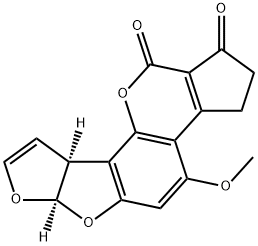아프라톡신 B1 C화학적 특성, 용도, 생산
물성
Aflatoxin(AF)은1960년6에 영국에서 처음 밝혀졌으며, Aspergillus flavus와 그 독소에 오염된 땅콩 사료를 먹은 칠면조 100,000마리 이상이 죽어 “Turkey X Disease"로 알려졌다. 밝혀진 18종의 아플라톡신 중 B1, B2, G1, G2가 주요 독소이고 아플라톡신 B1이 가장 흔히 발견되고 또한 가장 강력한 독성을 가졌다. 아플라톡신 B1은 간장에서 cytochrome p450(CYP)에 의해 활성화되고, 신장에서는 peroxidase에 의해 아플라톡신 B1 8,9-oxide로 변화하여 DNA에 결합하여 강력한 발암작용을 나타낸다.
존재
온도가 24-35℃, 수분이 7% 이상일 때 Asp. flavus와 Asp. parasiticus에 의해 생성되는 2차 대사산물이다.
개요
Aflatoxin B1은 실험동물에서는 돌연변이, 발암 및 기형 등을 일으키며 사람에게는 간암을 일으키는 물질 중의 하나로 알려져 있으며, IARC(International Agency for Research on Cancer)에서는 아플라톡신을 인체 발암을 일으키는 Group 1 발암물질로 정의하고 있다. 대부분의 나라에서는 아플라톡신 B1, 또는 B1, B2, G1, G2를 포함한 총 아플라톡신으로 허용기준치를 정해놓고 있고 아플라톡신 M1에 대해서도 규제를 하고 있다.
독성
아플라톡신 B1은 강력한 간독성 및 간암을 일으키는 물질로 심각한 아플라톡신 감염증상은 간의 출혈괴사, 담관 증식, 부종과 졸음을 동반한다. 성인은 아플라톡신에 대해 높은 내성을 가진다고 보고되어 있으며 어린이들은 사망에 이르기도 한다.
화학적 성질
The aflatoxins are a group of molds produced by the fungus Aspergillus flavus. They are natural contaminants of fruits, vegetables, and grains. They are also described as a series of condensed ring heterocyclic compounds. They form colorless to pale yellow crystals. Practically insoluble in water.
용도
Aflatoxin B1 is the major analogue of a family of bisfuranocoumarin mycotoxins produced by Aspergillus flavus and related species. Aflatoxin B1 exhibits a distinctive UV spectrum and blue fluorescence. Aflatoxins are among the most potent mycotoxins known but are in fact "pre-toxins", requiring metabolic activation to the toxic principle. Aflatoxins are found widely in nature in trace amounts, particularly in grains and nuts. The toxicity of these metabolites was first recognised in the 1950s and their structures elucidated in 1963. Aflatoxins have been extensively reviewed.
정의
ChEBI: An aflatoxin having a tetrahydrocyclopenta[c]furo[3',2':4,5]furo[2,3-h]chromene skeleton with oxygen functionality at positions 1, 4 and 11.
일반 설명
Colorless to pale yellow crystals or white powder. Exhibits blue fluorescence.
공기와 물의 반응
Sensitive to exposure to air and light. Water insoluble.
반응 프로필
AFLATOXIN B1 is incompatible with strong oxidizing agents, strong acids and strong bases.
화재위험
Flash point data for AFLATOXIN B1 are not available; however, AFLATOXIN B1 is probably combustible.
Safety Profile
Confirmed human carcinogen with experimental tumorigenic, neoplas tigenic, and carcinogenic data. Acute poison by ingestion, intraperitoneal, and possibly other routes. Experimental teratogenic and reproductive effects. Mutation data reported. When heated to decomposition it emits acrid smoke. See also various aflatoxins.
잠재적 노출
Aflatoxins are a group of toxic metabolites produced by certain types of fungi. Aflatoxins are not commercially manufactured; they are naturally occurring contaminants that are formed by fungi on food during conditions of high temperatures and high humidity. Most human exposure to aflatoxins occurs through ingestion of contaminated food. The estimated amount of aflatoxins that Americans consume daily is estimated to be 0.15 0.50 μg. Grains, peanuts, tree nuts, and cottonseed meal are among the more common foods on which these fungi grow. Meat, eggs, milk, and other edible products from animals that consume aflatoxincontaminated feed may also contain aflatoxins. Aflatoxins can also be breathed in
신진 대사 경로
Aflatoxin B1 can be activated via the monooxygenase
reaction which then reacts with the N7 atom of B-DNA
guanine. Conjugation of aflatoxin B1 8,9-epoxide is an
important detoxification route. Although aflatoxin B1
8,9-epoxide can be hydrolyzed to the diol by epoxide
hydrolase, the diol product is toxic, since it reacts
readily with proteins by Schiff base formation or binds
to DNA. Glutathione conjugation prevents toxicity of
both the epoxide and its hydrolysis product. The
aflatoxin glutathione conjugate is subsequently
excreted from the hepatocyte into bile as a major
biliary metabolite.
운송 방법
UN3172 Toxins, extracted from living sources, solid or liquid, Hazard Class: 6.1; Labels: 6.1-Poisonous materials, Technical Name Required. UN2811 Toxic solids, organic, n.o.s., Hazard Class: 6.1; Labels: 6.1-Poisonous materials, Technical Name Required.
비 호환성
Incompatible with oxidizers (chlorates, nitrates, peroxides, permanganates, perchlorates, chlorine, bromine, fluorine, etc.); contact may cause fires or explosions. Keep away from alkaline materials, strong bases, strong acids, oxoacids, epoxides.
폐기물 처리
Consult with environmental regulatory agencies for guidance on acceptable disposal practices. Generators of waste containing this contaminant (≥100 kg/mo) must conform with EPA regulations governing storage, transportation, treatment, and waste disposal. Use of oxidizing agents, such as hydrogen peroxide or 5% sodium hypochlorite bleach. Acids and bases may also be used.
아프라톡신 B1 준비 용품 및 원자재
원자재
준비 용품








